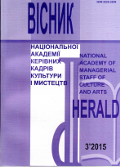СТАНОВЛЕННЯ ТА РОЗВИТОК ПРАВОСЛАВНИХ ПАРАФІЯЛЬНИХ УЧИЛИЩ НА ПОДІЛЛІ:
перша половина XIX ст.
The formation and development of the orthodox parochial schools in Podolia (the first half of the XIX century)
Author(s): Anna SviatnenkoSubject(s): Education, Cultural Anthropology / Ethnology, Eastern Orthodoxy
Published by: Національна академія керівних кадрів культури і мистецтв
Keywords: elementary spiritual institutions; Podolyya; clergy; Spiritual Education; pupils;
Summary/Abstract: In the article the activities of the Orthodox religious primary ecclesiastical schools in Podolia office at the the be-ginning of the XIX century are analyzed. The problems of the ecclesiastical schools’ network, the financial support, the forming of the teaching body and the students contingent are highlighted.Keywords: development of the Orthodox parochial schools, Podolia, the first half of the XIX century.At the beginning of the XIX century the stepwise system of Orthodox ecclesiastical schools was established as the result of the total reform of theological education in Podolia and in Ukraine particularly. The basis of its system was the principle of unification of the education, which was accompanied by the centralized management of educational institutions. The statute of the clerical parochial schools, approved 30 August 1814, comprised the principles of the educational and economic life of primary schools.There were five parochial schools in Podolia at the beginning of the XIX century. Their number remained without any changes despite of the legally established norms which allowed 30 clerical primary schools in every diocese.The superintendent of schools or the rector and the inspector were responsible for the internal management of it. On these posts the academic board appointed people who had high theological education, good moral features and responsibility. The supervisors were mostly the teachers of seminaries.The important part of the schools’ functioning was the formation of the teacher staff. This case was the most important that why the selection had to held properly. Only the best graduates of Podolia’s Seminary got the teachers' posts.The educational activities of the schools needed the great centralization. The schedule of subjects for studying, the control checking of the knowledge were given by the board and unified for all schools.The problem of material support of parochial schools was stable. Since 1818 schools were financed by the in-comes from the sale of church candles and percents from the academic capital which consisted of economic residues. The fixed staff amounts were minimal and included keeping of schools, salaries of the school managers and teachers and supporting of the students who couldn’t pay for studying.Despite of the weak material schools’ assistance, the part of children had the opportunities to get a free or half-free education. The benefits concerned exclusively the orphans and children from poor families. Each year the number of beneficiaries increased. The real number of free students considerably exceeded the number, fixed by the staff. The diocesan leader-ship looked for different sources to keep them.The administration of the college had to find the places of housing for its pupils. They had some problems with the provision of the textbooks and other educational literature. The pupils who did not pay for studying, received free books.So, the result of the general clerical educational reform in Podolia was the formation of the network of parochial schools where children of Orthodox and Greek-Catholic clergies and secular people got the knowledge.The activities of schools were totally controlled by the senior management, regulated by numerous laws and orders of state and church authorities. The specific incentive and binding measures of the necessity of education contributed to raising literacy among the Orthodox clergy. The practices of a high-quality selection of teachers, the introductions of new teaching methods, the preferential distribution of textbooks, the giving the right to free education for orphans and children from poor families were useful.
Journal: Вісник Національної академії керівних кадрів культури і мистецтв
- Issue Year: 2015
- Issue No: 3
- Page Range: 64-70
- Page Count: 7
- Language: Ukrainian

